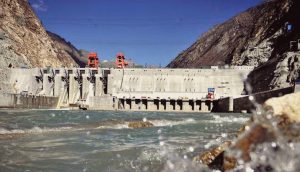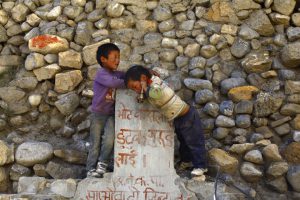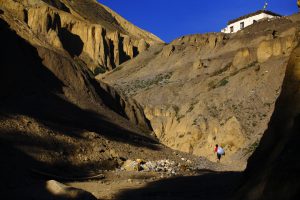Assam, in North-east India, produces one of the finest, and most expensive, types of silk in the world. Produced by the semi-domesticated silkworm Antheraea assamensis, which is only found in the Brahmaputra Valley, this silk is called Muga – Assamese for “yellow” or “amber” – and is often called golden silk. This silk has been produced in the region from as far back as 321 BC, and is an inextricable part of the life and culture of Assam. Unfortunately silkworms are highly sensitive to climatic conditions since they are grown outdoors. Recently unpredictable rainfall patterns, a rise in temperature and persistent floods have endangered Muga cocoon production across the state.
Due to the long history of sericulture, Muga silk occupies a special place in the lives of the indigenous people, inextricably linked to their cultural life. Moreover Muga silk is one of the most expensive silks in the world due its durability and beauty. The lustre of the fabric increases with each wash, making it a product that is treasured – and which lasts – throughout the lifetime of its owner. In 2007, Assam received the Geographical Indication (GI) tag for Muga silk. A GI tag is given to products that are produced in a particular area, and boosts the reputation of the product.
There is a demand for more than 5,000 metric tonnes (mt) of Muga silk annually, but the state has been producing an average 90 mt per year. In 2011-12 the production increased a little to 115 mt, according to sources from the Sericulture Department. However there are fears of negative or stagnant results in the next crop seasons. This year’s crop production was affected by rising temperature and floods.
A flood of troubles in Dhemaji
The Dhemaji district in northern Assam is a major Muga growing area. About 98% of the people of the district live in the rural areas and agriculture is the principal occupation for more than 85% of the people. These families are also engaged in Muga cultivation. Muga cultivation is a labour intensive activity and almost all the family members of the household are involved in silkworm rearing, silk reeling and weaving. Unfortunately for the farmers of Dhemaji floods are destroying the basis of this industry.
The district has experienced recurrent floods, on an annual basis for the last few years. The Dhemaji Agriculture Department put the number of farm families affected this year at 50,500. Assam has an average family size of just under 5 people per family, which would mean that almost 250,000 people would have been affected out of a total population of about 700,000. A total of 3,718 hectares of agricultural land was covered in silt this year, pushing the affected people to search alternative livelihood in non-agricultural sector.
The floods and siltation have destroyed, or endangered, plantations of the Som plant, on which the Muga silkworms feed. The Som plantations – known as Sumonis – have been gradually destroyed as they have either been displaced, or their roots buried in sandy silt. Kusha Sonowal of Laomuri village, Dhemaji, said that the unavailability of good quality seeds has severely affected indigenous Muga rearing. Abandoning her expertise in weaving, she now helps her family run a small tea stall some 2 kilometres from her home.
Loss linked to change in temperature and humidity
Joya Duvarah, who now runs a small shop near the main road in Laomuri village, laments that her family would have earned millions if only their once prosperous Muga cultivation thrived. The chronic havoc of flood brought disaster and they had to cut down hectares of their Som plantations that had rotted after being submerged for months. “Apart from floods that have eaten away our Sumonis, a rise in temperature has brought down the production. The silkworms that are grown outside cannot bear so much heat. Vagaries of weather are responsible for premature death of worms.” she added.
The silkworm needs temperatures of around 30-35 degree Celsius and a humidity level of 80-85% in order to thrive. Dhemaji suffered heavy losses in Muga production in the last couple of years as silkworms died out due to the increase of air temperature and humidity, according to the Sericulture Department of Assam. The current records show the annual rainfall of the district ranges from 2600 mm to 3200 mm, the relative humidity varies from 90% to 73% while the temperature varies between 39.9C in summer and 5.9C in winter. Changes in temperature and humidity lead to diseases like Flacherie, and Grasserie that can wipe out an entire lot of silkworms.
The Tocklai Experimental Station, the premier body in tea research in the state and the oldest tea research station in the world, has observed that in the last 90 there has been a rise in temperature of 1.5C in many areas, and that the rainfall has decreased by 200mm on average, and is now down to 2,800mm a year. Climate change compels tea cultivators to use more pesticides to kill pests and mites in their garden. This pesticide contaminates the air, and silkworms die when they breathe in the pesticides used in tea gardens nearby.
Though climate change has been affecting silkworms in Assam, there is no research or planning to save the glorious silk of Assam. Sources at the zonal office of the Central Silk Board in, Guwahati, the state capital, say that the board has not initiated any study on the impacts of climate change on Muga silk production.
![<p>A set of mekhela chadors made with Assamese muga silk arranged around a japi [image by Satnath]</p>](https://dialogue.earth/content/uploads/2015/10/Assamese_Muga_With_Japi-300x244.jpg)





